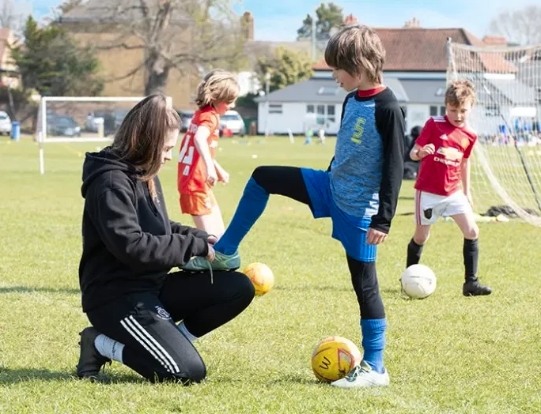Child safety should always be the top priority in any activity involving young individuals, and football training is no exception. As young players lace up their boots and take to the pitch, it is crucial to create a safe and secure environment that protects their well-being. In this article, we will explore the essential measures and guidelines implemented to ensure child safety in football training. From facilities and equipment safety to qualified coaches and age-appropriate training methods, we will delve into the key areas of focus and best practices adopted to safeguard young footballers.
Facilities and Equipment Safety.
The first step in ensuring child safety lies in the proper maintenance of facilities and equipment. Football pitches and training grounds should be well-maintained, free from hazards that may pose a risk to young players. Regular inspections and repairs should be conducted to address any uneven surfaces, debris, or other potential dangers. Furthermore, providing age-appropriate and well-fitting protective gear, such as shin guards and goalkeeping equipment, is vital to minimizing the risk of injuries.
Qualified and Trained Coaches.
The presence of qualified and trained coaches is paramount in creating a safe training environment for young footballers. Coaches should undergo thorough background checks and screenings to ensure their suitability for working with children. Possessing the necessary qualifications, certifications, and training in child safety is essential. Coaches should also be knowledgeable in first aid and emergency procedures to handle injuries and medical emergencies effectively. Clear protocols should be established for responding to injuries, including communication with parents and involving medical professionals when necessary.
Age-Appropriate Training Methods.
Training methods should be tailored to the age and developmental stage of young players. It is crucial to design sessions that align with their physical and cognitive abilities, avoiding excessive physical demands or drills that may increase the risk of injuries. Incorporating proper warm-up and cool-down routines is essential to prepare players’ bodies and prevent injuries. Teaching young players about the importance of stretching and warm-up exercises will help instill good habits from an early age.
Hydration and Nutrition.
Proper hydration and nutrition are integral to the overall health and well-being of young footballers. Coaches should ensure that players have access to clean drinking water throughout training sessions and schedule regular rest breaks to allow them to hydrate and recover. Players’ overall energy levels and performance will improve if they are taught about the importance of balanced meals and snacks and healthy eating habits.
Safe Practices and Preventing Injuries.
Forestalling wounds ought to be fundamentally important in football preparing. Injury risk can be significantly reduced by implementing injury prevention programs that include exercises to strengthen muscles, joints, and improve flexibility. Injury rates can be further reduced by teaching young players safe play and proper tackling techniques. In addition, recognizing the significance of rest and recovery is essential for avoiding burnout and injuries caused by overuse. Establishing guidelines for appropriate training frequency and duration based on age and individual needs is crucial.
- Communication and Reporting.
Open and effective communication channels are essential in ensuring child safety. Coaches, parents, and players should have open lines of communication to address any concerns or incidents promptly. Creating a safe space where players feel comfortable reporting any issues they may encounter is crucial. Furthermore, establishing clear reporting and response protocols for suspected or actual incidents of abuse, neglect, or misconduct is vital. Working in compliance with local child protection laws and regulations will help maintain a safe environment for young players.
When it comes to football training involving children, there is no compromise when it comes to their safety and well-being. By prioritizing child safety and implementing comprehensive measures, organizations, coaches, and parents can create a secure environment where young footballers can flourish. From ensuring facilities and equipment safety to providing qualified coaches, age-appropriate training methods, and promoting proper hydration and nutrition, every aspect of child safety in football training plays a vital role.
Organizations and governing bodies must clearly establish protocols and guidelines that place child safety first. To guarantee that safety regulations are adhered to, regular audits and inspections ought to be carried out. It is necessary to provide mentors, staff, and guardians with more advanced training and instruction in order to improve their ability to interpret security and well-being measures for children.
A culture of open communication, inclusivity, and respect must also be developed. Players ought to feel open to communicating their interests or detailing any episodes unafraid of repercussions. Staff and coaches should receive training on how to recognize and respond to signs of abuse, neglect, or misconduct. Timely and thorough investigations should be conducted if any allegations arise, with full cooperation with relevant authorities.
Parents and guardians also play a vital role in ensuring child safety in football training. They should actively engage with coaches and staff members, asking questions about safety measures and policies in place. Parents should familiarize themselves with the signs of potential abuse or neglect and maintain open lines of communication with their children to monitor their experiences and well-being.
Child safety must always be the highest priority in football training environments. By implementing a comprehensive approach that encompasses facilities and equipment safety, qualified coaches, age-appropriate training methods, hydration and nutrition, injury prevention, and effective communication and reporting, we can create a secure and nurturing environment for young footballers to thrive.
Every child deserves the opportunity to pursue their passion for football in a safe and supportive setting. It is the collective responsibility of coaches, organizations, parents, and governing bodies to ensure that child safety is upheld at all times. By committing to these measures and continuously striving to improve safety standards, we can provide young footballers with an environment where they can develop their skills, build lifelong friendships, and enjoy the beautiful game with confidence and peace of mind.


Leave a Reply